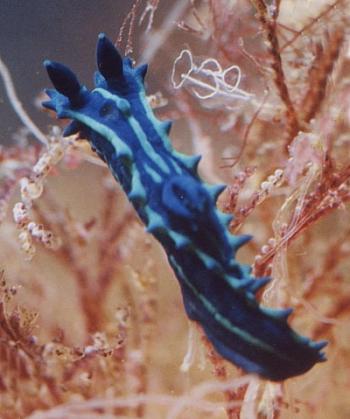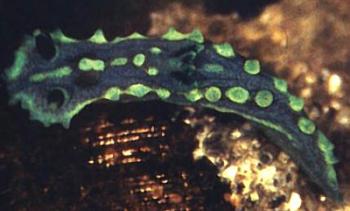
Tambja ceutae
Garcia-Gomez & Ortea, 1988
Order: NUDIBRANCHIA
Suborder: DORIDINA
Superfamily: ANADORIDOIDEA
Family: Polyceridae
Subfamily: Nembrothinae
PHOTO
Juvenile showing conspicuous tubercles around mantle edge. Straits of Gibraltar, southern. PHOTO: Juan Lucas Cervera.
Tambja ceutae is similar in external appearance to Roboastra europaea. The most distinguishing external feature is the presence of pointed tubercles (variable in size) along the edge of the notum, moreover on the back of the tail. These are more conspicuous in juveniles than in adults. In adults, the light blue lines of juveniles are yellow. Species of Tambja graze on bryozoans.
References:
• Garcia-Gomez, J.C. & Ortea, J.A. (1988) Una nueva especie de Tambja Burn, 1962 (Mollusca, Nudibranchia). Bull. Mus. Natl. Hist. Nat. Paris, 4, 10, sect A 2: 301-307.
• Sanchez-Tochino, L., Garcia, F.J., Ocana, A. (2000) The genus Tambja Burn, 1962 (Gastropoda, Opisthobranchia) in the Mediterranean Sea with remarks on the intraspecific variability. Argonauta, 14(1): 67-75.
Rudman, W.B., 2001 (February 11) Tambja ceutae Garcia-Gomez & Ortea, 1988. [In] Sea Slug Forum. Australian Museum, Sydney. Available from http://www.seaslugforum.net/find/tambceut
Related messages
Tambja ceutae from Spain
March 9, 2001
From: Alma Sánchez

Dear Dr Rudman,
Here is a photo I sending you with authorization) of a juvenile specimen of Tambja ceutae García-Gómez & Ortea, 1988. This photo was taken by Prof. Luis Sánchez Tocino (University of Granada). This specimen was collected in October, 1996. Size: 10 mm long. Depth: 7 m . Place: Cerro Gordo (Almuñécar, Granada - Spain).
Best wishes,
Alma Sánchez.
Almasanchez83@hotmail.com
Sánchez, A., 2001 (Mar 9) Tambja ceutae from Spain. [Message in] Sea Slug Forum. Australian Museum, Sydney. Available from http://www.seaslugforum.net/find/3908Dear Alma,
Thank you and Professor Sánchez Tocino for the photo
Bill Rudman
Re: Tambja ceutae from Spain
February 23, 2001
From: Juan Lucas Cervera
Dear Bill,
In answer to your question about colour variation between adults and juveniles, effectively, Tambja ceutae varies in color depending of the age of the animal, as well as the relative size of the tubercles respect the body. Thus, usually, the yellow lines of the adults are greenish or green-bluish in juveniles. Even in adults, the width of the yellow lines can be different as you can see in the Peter Wirtz's book (1995) Underwaterguide Madeira, Canary Islands, Azores or Peter Wirtz's article (1998) 'Opisthobranch Molluscs from the Azores', Vita marina, 45(1-2): 1-16, in which you can see 2 specimens of this species, one of them called Roboastra europaea/Tambja sp. (depending of the reference).
Last year, Sanchez-Tocino, Garcia and Ocaña (2000) published a color plate in their paper "The genus Tambja Burn, 1962 (Gastropoda, Opisthobranchia) in the Mediterranean Sea with remarks on the intraspecific variability", Argonauta, 14 (1): 67-75, in which is possible also to see the external differences between and juvelile and adult specimens of this species.
In a separate mail I sending you a photo of Tambja marbellensis Schick and Cervera, 1998, also from southern Iberian Peninsula.
Cheers.
Lucas.
lucas.cervera@uca.es
Cervera, J.L., 2001 (Feb 23) Re: Tambja ceutae from Spain. [Message in] Sea Slug Forum. Australian Museum, Sydney. Available from http://www.seaslugforum.net/find/3796Dear Lucas,
Thanks for the photo of Tambja marbellensis which I have put on a separate page.
Bill Rudman
Re: Tambja ceutae from Spain
February 11, 2001
From: Juan Lucas Cervera

Dear Bill,
Alma's photos which you thought might be Tambja ceutae belong to Roboastra europaea. This species has two colour forms, one light (more yellowish/orange) and other darker. These photos show the darker form. Her other photos were of the lighter form.
The most relevant external feature of Tambja ceutae is the presence of pointed tubercles (variable in size) along the edge of the notum, moreover on the back of the tail.
Here is a photo of a juvenile of this species, from the Strait of Gibraltar. The tubercles in juveniles are more conspicuous.
Cheers,
Lucas.
lucas.cervera@uca.es
Cervera, J.L., 2001 (Feb 11) Re: Tambja ceutae from Spain. [Message in] Sea Slug Forum. Australian Museum, Sydney. Available from http://www.seaslugforum.net/find/3778Dear Lucas,
Thanks for sorting this out. I decided with the blue chromodorids to always check with a Mediterranean expert first before posting species from that region, but Garcia & Ortea's two large colour photos in their original description look remarkably like Alma's photos. Do the lines in T. ceutae change to a creamy yellow in adult specimens?
I have fixed the pages for these two species
Best wishes,
Bill Rudman
